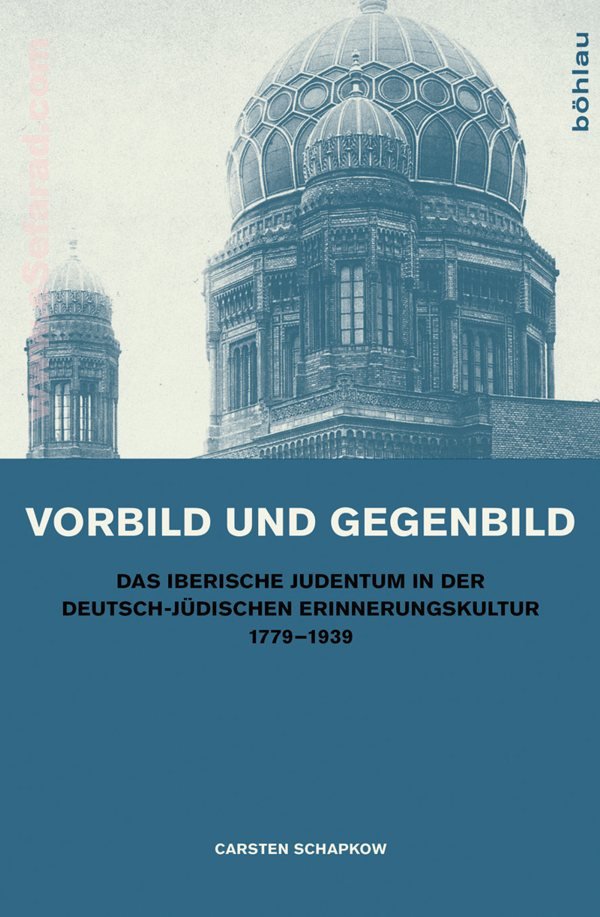Carsten Schapkow have just recently published a book discussing the perception of Iberian-Sephardic History among German-Speaking Jews from 1779 until 1939. The book is published in German by Böhlau Publishers (Cologne, Weimar, Vienna) this October 2011.
Carsten has been contacted by eSefarad and tell us the following:
My new book Vorbild und Gegenbild. Das iberische Judentum in der deutsch-jüdischen Erinnerungskultur 1779-1939 [Cologne: Böhlau Publishers 2011; Title in English: Role Model and Counter Image. Iberian Jewry and the perception in German-Jewish Remembrance Culture 1779-1939] provides an innovative interpretation of German-Jewish history during the era of Jewish emancipation.
Since no book-length study of this topic has been published, mine will be of particular interest to scholars, graduate students and advanced undergraduate students in the fields of Modern Jewish History and Sephardic History.
In the book, I explore how 19th century German Jews perceived and idealized the ability of Sephardic Jews in medieval Spain to incorporate themselves into Spanish society while maintaining their Jewish identity. This perception and idealization had political significance, shaping the way 19th century German Jews envisaged Jewish incorporation in German society.
For German-speaking Jews, the history of Sephardic Jewry became a historical example with its distinctive valence and signature within German national history. While Zionist authors rejected the myth of Sephardic Supremacy, and Zionism in general turned to the biblical past for a useful model, 19th century German Jewry found the Iberian experience an indispensable linchpin in its struggle for a modern Jewish identity. In this respect a notion of intercultural mediation is of central significanceemphasizing the skills and values Jews had to offer to civilization in the past and can still play a part in present and future societies namely in Germany.
In researching the book, I consulted wide-ranging sources but paid particular attention to texts that circulatedboth within and between the spheres of elite and popular cultures. Dialogue between these spheres is particularly evident in the popularliterature and journalism of the day, and my findings show that it was through these forms of mass expression that elite commentators on Iberian-Sephardicculture in Germany found a forum in which to express them politically. This is best described when the German Reform Rabbi Ludwig Philippsonpetitioned the Spanish Government for libertad de cultos in the 1850s, which provoked a debate in Spain as well.

The manuscript is already translated into English, however, at this point the author is looking for a publishing house that would be interested in publishing the translated version.
The reader can find the table of contents in English with the prologue, a introduction, and the description of the Book Proposal in this PDF document.
If you have any idea which publishing house might be interested in doing this please let us know at eSefarad@eSefarad.com.
——————

Carsten Schapkow
Vorbild und Gegenbild
Das iberische Judentum
in der deutsch-jüdischen
Erinnerungskultur 1779–1939
2011. 456 S. Gb. 155 x 230 mm.
€ 54,90 [D] / € 56,50 [A]
ISBN 978-3-412-20766-3
Die im maurischen Stil erbaute Synagoge in der Oranienburger Straße von Berlin versinnbildlichte wie kein anderer Ort in Deutschland sowohl das Selbstbewusstsein des deutschen Judentums wie auch die Vorbildfunktion der iberisch-sephardischen Kultur. Dieses Phänomen wird im vorliegenden Werk in all seinen Ausprägungen untersucht.
Dass die jüdische Geschichte auf der iberischen Halbinsel dabei nicht nur als Goldenes Zeitalter wahrgenommen wurde, sondern in Abgrenzung dazu auch viele Gegenentwürfe entstanden sind, die die Entwicklung einer modernen deutsch-jüdischen Identität seit dem 18. Jahrhundert entscheidend geprägt haben, ist die zentrale These des Buches.
Der autor: Carsten Schapkow ist Assistant Professor of History and Jewish Studies an der Universität von Oklahoma.
[print_link]
 eSefarad Noticias del Mundo Sefaradi
eSefarad Noticias del Mundo Sefaradi

